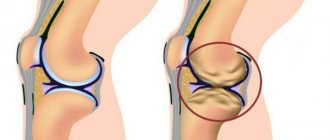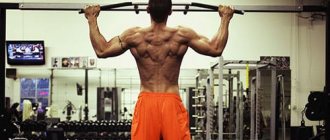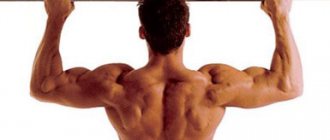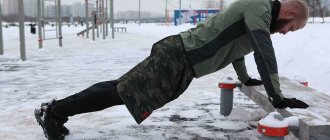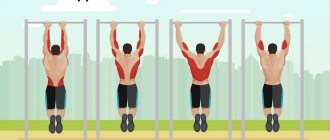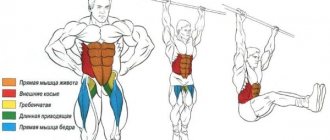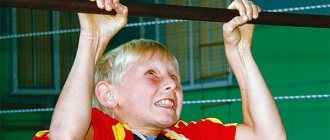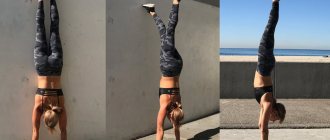How to do pull-ups on the horizontal bar correctly and why to do it: Unsplash Pull-ups on the horizontal bar are a multifunctional exercise that can be performed in the gym, at home, or on the playground. With its help, the muscles of the arms and shoulders are strengthened, making them more prominent. To achieve this effect, you need to adhere to the correct technique for performing the exercise and choose the appropriate program.
How to quickly learn to do pull-ups: where to start
To begin with, the muscles must be prepared, that is, pull-ups must be preceded by other exercises in the gym or at home that strengthen the whole body. When starting to train from scratch, your muscles will need about a month to adapt to the strength load, after which it will be easier for them to lift weights and perform more complex exercise techniques. To prepare the muscles for pull-ups, it is necessary to perform a complex of initial level of physical fitness, strengthening all muscles symmetrically. The main working muscles during pull-ups are the back and arms (biceps, forearms) , but despite this, you need to simultaneously train the antagonist muscles (back - chest, biceps - triceps). Helpers for pull-ups will be all kinds of rows, presses, push-ups from the floor and reverse push-ups from the bench.
Read more about exercises to prepare for pull-ups →
It's time to learn if you still don't know how.
@vitaliy.feschuk
So, last time we told you how to do push-ups a hundred times in one approach, and today we’ll try to explain how to learn how to do pull-ups on the horizontal bar from scratch and not screw up in front of seasoned workout athletes.
If you found this guide, then you probably know very well how useful pull-ups can be. Like push-ups, pull-ups are one of the most classic and effective bodyweight exercises.
With the help of them, you will not only be able to properly pump up all the muscles of the upper body, but also climb back into the apartment through the window when hanging from the windowsill (you never know what situations happen in life).
To be a little more precise, pull-ups help:
- form a beautiful relief of the muscles of the arms, shoulders, chest and back;
- strengthen joints and ligaments;
- maintain a healthy spine;
- move on to more complex physical exercises.
Unfortunately, we won’t be able to say exactly how long it will take you to learn how to do pull-ups. After all, it all depends on your physical fitness and some other factors (weight, experience, your desire, and so on).
For example, if earlier in your school years you knew how to do pull-ups, you will be able to remember how to do this in about three to five weeks. If you have never approached a horizontal bar in your life, the process can take up to six to nine weeks.
Moreover, if you are already working out in the gym and actively lifting barbells, dumbbells and other equipment, this does not mean that you will be able to pull yourself up. After all, working with your own weight and working with outside weights are two different philosophies.
It is also worth noting that in some cases, pull-ups are contraindicated for people with scoliosis, intervertebral hernias, osteochondrosis, protrusions and arthrosis. Therefore, if you are not sure that the horizontal bar is safe for you, consult your doctor. He'll tell you everything.
Pull-up program for beginners
After strengthening all major muscle groups, you can move on to preparatory exercises that speed up the learning process from scratch. Also, these exercises can be started from the first day of training, including them in a complex for the development of all muscles.
Horizontal pull-ups
The simplest method of pull-ups, but the main one for beginners, is mastering the technique of horizontal pull-ups. To develop muscles and further progress in vertical pull-ups, perform the exercise for the maximum number of repetitions, constantly increasing the load (incline and quantity). The more horizontal the position of the torso, the more difficult the load. Perform pull-ups until your muscles stop working.
- Place your hands on a low bar with a wide grip.
- Place your feet in front of the bar, remaining hanging with your arms straight, your body at an angle (depending on the required degree of load).
- The abdominal, lower back and gluteal muscles are tense, keeping the entire body in one plane (without sagging or unnecessary deflections).
- As you exhale, pull the middle of your chest toward the bar, bend your elbows at the level of your shoulder joints and bring them back behind your shoulder blades.
- As you inhale, straighten your elbows, keeping your torso straight.
To increase the load on the feet, you can place them on a height , such as a bench, so that the torso will be horizontal - parallel to the floor. You can also perform the technique with a medium reverse grip, alternating exercises for a maximum number of repetitions for 3-4 sets.
Pull-ups with help
After mastering horizontal pull-ups, move on to vertical pull-ups with an assistant. To improve your grip, use special pull-up straps or gloves. Hanging on straight arms, bend your knees, the assistant can push the body weight, holding the knees from below, or hold the palm between the shoulder blades, pushing the thoracic area upward.
- Place your palms with a medium to wide overhand grip, slightly wider than shoulder-width apart, while standing on a bench.
- Come out in a hanging position, bend your knees.
- As you exhale, try to pull your middle chest toward the bar with the help of a partner who determines the force of the push himself, only pushing the body for the jerk, and not pushing the weight out on his own.
- As you inhale, do not rush to lower yourself, slowly straighten your elbows and continue to perform the maximum amount until all your strength is exhausted for one more repetition.
Also, with the help of a partner, change your grip technique to wide, narrow, reverse and parallel - developing all muscles symmetrically. When training on your own, use elastic bands or a gravitron exercise machine, which provide a counterweight and lighten the load.
Half amplitude pull-ups
You can learn how to pull yourself up correctly by performing a simple technique using half the range of motion. To do this you will need a bench and a horizontal bar.
- Stand on the bench so that, with a wide grip on the bar, your elbows form an angle, as in the middle of the pull-up range.
- As you exhale, tense your muscles, gathering all your strength for half the movement, and pull yourself up, pushing your chin towards the bar.
- As you inhale, slowly lower yourself onto the bench.
Gradually increase the range of motion, perform the maximum number of repetitions. Over time, it will be easier for the muscles to begin to pull up body weight from the lowest point.
Increased hanging time
To safely do all the exercises on the horizontal bar, you need to confidently hang on the bar. To do this, you need to strengthen your grip. To begin with, simply hang on the horizontal bar for as long as your wrist strength allows.
Start small: beginners can hang for 10-15 seconds, after which their hands open on their own. And the heavier a person is, the less time he can spend in a hanging position. When the hanging time reaches 30–40 seconds, you can think about pull-ups.
Elements such as muscle-ups require a stronger grip. Because, otherwise, your hands may fall off the bar, and falling from the horizontal bar is painful and traumatic.
Correct pull-up technique
Mastering proper technique will be the biggest part of your success in mastering pull-ups. Only a properly selected load will benefit the muscles, eliminating possible injuries - sprains, ruptures of muscles and ligaments. After the preparatory exercises, you can begin vertical pull-ups, constantly increasing the repetitions.
- Place your palms with a medium grip (slightly wider than shoulder width).
- Pull yourself up, exhaling powerfully, with your chin up to the bar.
- Keep your torso upright with your knees bent.
- As you inhale, don’t forget to lower yourself; make the downward movement more slowly.
Determine your category, and forward to success!
Before you start training, set yourself the exercises that you can do. Then you need to determine the group and, accordingly, the exercise program, which is designed for two weeks. A month after the start of serious professional training, it is necessary to undergo testing again.
Your result: from 0 to 1
Your difficulties: you are not ready yet (can’t support your weight)
What will help: the best option for you is to do only the reverse part of the pull-ups: use a bench to help, place it just below the crossbar, help with your legs to do the pull-up. Give yourself a minute of rest after each set.
Train according to the schedule:
First training week: 3 sets of 5-6 repetitions of the exercise, lowering time 5-6 seconds
Second training week: 3 sets of 5-6 repetitions of the exercise, lowering time 5-6 seconds
Third training week: 2 sets of 5-6 repetitions of the exercise, lowering time 8-10 seconds
Fourth training week: 2 sets of 5-6 repetitions of the exercise, lowering time 8-10 seconds.
Your result: from 2 to 4
Your difficulties: less than necessary number of repetitions during training
What will help : first, reduce the number of repetitions of the exercise while increasing the number of approaches. Focus on the first repetitions of exercises, as they allow you to establish the “brain-muscle” connection.
Train according to the schedule:
First training week: 8 sets, 50 percent of the maximum number of reps performed for the best set, 1.5 minutes rest.
Second training week: 8 sets, 50 percent of the maximum number of reps performed for the best set, 1 minute rest.
Third training week: 8 approaches, maximum number of repetitions performed for the best approach, 1.5 minutes rest.
Fourth training week: 8 sets, maximum number of reps performed for the best set, 1 minute rest.
Your result: from 5 to 7
Your difficulties : you have strength, but not enough endurance
What will help : increase the number of repetitions of the exercise. For example, if you previously performed 3 sets of 6 repetitions, do 30 repetitions, regardless of the number of repetitions in each approach.
Train according to the schedule : do pull-ups as many times as possible, rest for 1 minute, do more pull-ups as many times as you can.
Contraindications
Exercises on the horizontal bar have a small number of contraindications. People with diseases and disorders such as:
- Scoliosis (curvature of the spine);
- Herniated discs;
- Protrusion of the spine.
People with osteochondrosis should exercise on the horizontal bar with caution. On the one hand, exercises help to increase blood circulation and develop mobility of vertebral structures, on the other hand, excessive stress in case of degenerative changes in the vertebrae is contraindicated. People with osteochondrosis of the cervical spine should be especially careful: pull-ups can increase pain and cause dizziness.
How to end your workout
If you have time left, you can do a short cool-down by stretching for six minutes. It will help relax tense muscles and restore breathing.
Take the position and hold it for 30 seconds. Don't try to push your range of motion, breathe deeply and calmly.
Bend forward to stretch the hamstrings
Photo: Yulia Obolenskaya
Take a step forward, straighten your back and tilt your body until it is parallel with the floor. Feel the stretch in the back of your front leg.
You can straighten your knee or leave it bent. In the first version, more stretching is felt in the upper thigh, in the second - in the lower.
Standing hip flexor stretch
Photo: Yulia Obolenskaya
Bend your knee, grab your foot with your hand and pull your heel towards your buttock. Tilt your pelvis back to increase the stretch.
Elevated Pigeon Pose
Photo: Yulia Obolenskaya
Bend your knee and place one shin on a low horizontal bar or bench. Try to keep your hips level and don't slouch your back. If you don’t feel much tension, you can slightly tilt your body forward.
Chest and Shoulder Stretch Against a Wall
Photo: Alexander Starostin
Place your hand on the support, lower your shoulder and turn in the opposite direction.
Side stretch next to the rack
Photo: Alexander Starostin
Stand sideways to the horizontal bar or wall bars, raise your arm above your head and grab the support. Holding onto the counter, move your pelvis to the side, stretching your side.
Technical points
Pull-ups must be performed using correct technique. Let's remember once again what it is:
- If you are hanging on a horizontal bar, it is advisable not to swing from side to side.
- All movements occur due to muscles, and not due to inertia or jerking. Even if you decide to work “in the negative,” there is no point in rising above the bar using a jerk.
- You should breathe so that you rise as you exhale, and as you inhale you go down. It is physiologically correct to make an effort while exhaling.
- If you start to sway during the exercise, which happens, do not continue the pull-up until your body stops swaying.
- Each hand position on the horizontal bar is designed to load a specific muscle group. Therefore, your task is to understand well what exactly you are pumping and try to work the right muscles while performing the exercise. For example, you can pump your biceps on the horizontal bar, or you can pump your back. By training your biceps, your total mass will not increase significantly. It's just a fairly small muscle. But by building up the large back muscles, this can be achieved. Therefore, focus specifically on the latissimus dorsi muscles. The biceps should be loaded last (that is, at the end of the workout).
